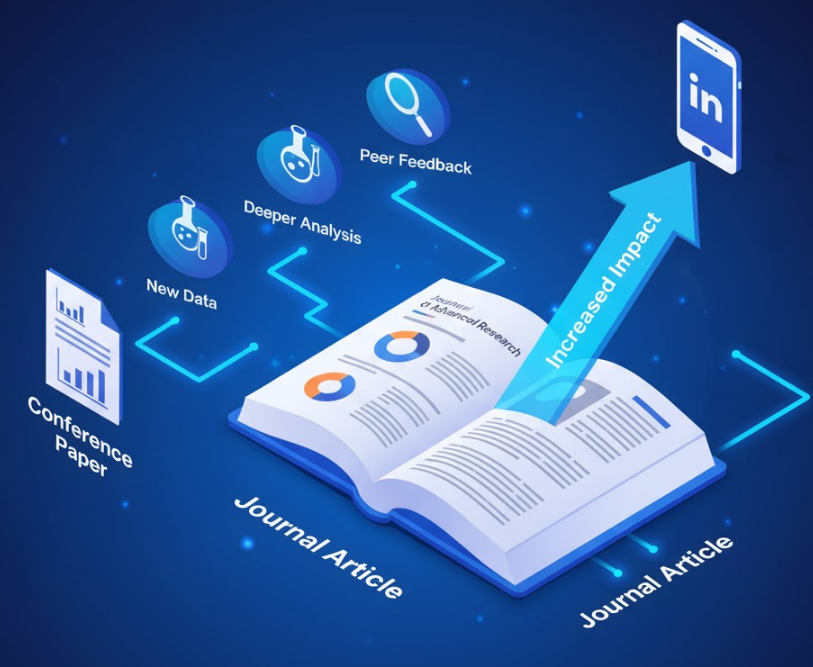

160 views||Release time: Oct 27, 2025
Presenting at a conference is a milestone, but transforming that conference paper into a full journal article is a critical step for maximizing your research's impact, reach, and academic weight. This process, however, is far more complex than a simple "copy and paste." It requires significant new work, a strategic shift in focus, and a clear understanding of ethical publishing guidelines.

This guide provides a step-by-step framework for successfully converting your conference paper into a high-impact, citable journal article.
The single most important concept in this process is "substantial new material." You cannot republish the same work in two places. To be considered a new, original publication, a journal article derived from a conference paper must provide significant new contributions.
While there is no universal law, a common guideline is the "30% rule": the journal article should contain at least 30% new, original content. This cannot just be rewriting sentences. It must be a substantial expansion, such as:
New Experiments or Data: Including additional case studies, larger datasets, or new experimental validations.
Deeper Analysis: Providing a more thorough and in-depth analysis of the existing data.
Expanded Theoretical Framework: Adding a much more detailed literature review, methodology section, or theoretical grounding.
New Findings or Conclusions: Presenting new insights that were not included in the original conference paper.
Follow these steps to ensure a smooth and ethical conversion process.
Before you write a single word, check the copyright agreement you signed with the conference publisher (e.g., IEEE, ACM, Springer).
Does the publisher permit a "significantly expanded" version? Most do, but you must check.
What are the requirements? They will almost always require you to explicitly cite the original conference paper.
Do not just aim for the highest-impact journal. Choose a journal that is a good fit for your expanded work.
Scope: Does your new, deeper analysis fit the journal's aims and scope?
Audience: A journal audience is broader and less specialized than a conference audience.
Turnaround Time: Journals are much slower than conferences.
A conference paper is often about preliminary results or a novel idea. A journal article must present a complete, robust, and validated story.
Introduction: Rewrite it completely. It needs to be more comprehensive, establish a stronger gap in the literature, and clearly state the novel contributions of this journal version.
Methodology: This section must be significantly expanded. Provide enough detail that another researcher could perfectly replicate your work.
Results & Discussion: This is where your 30% new material should shine. Add your new data, new analysis, and expanded graphs. The "Discussion" section, often short in conference papers, must be deeply reflective, connecting your findings back to the wider field.
Conclusion: Write a new conclusion that reflects the full scope of the journal article, not just the conference findings.
This is a non-negotiable step for ethical publishing. When you submit your manuscript, you must state in your cover letter that the work is an expanded version of a previously published conference paper.
Provide a copy: Include the original conference paper with your submission.
Summarize the new material: Add a short paragraph explicitly stating what is new in the journal version (e.g., "This journal article expands upon our work in [Conference Name] by adding a new longitudinal study, a detailed statistical analysis of...").
One of the greatest assets you have is the feedback you received at the conference. The questions from the audience and the discussions with peers are a goldmine.
Use these insights to preemptively address potential weaknesses.
Strengthen your arguments based on the critiques you received.
This is a key benefit of attending high-quality, well-organized academic events. When a conference is managed effectively, it creates a perfect environment for this kind of critical feedback. Professional platforms like www.iconf.com specialize in managing the logistics of academic conferences, helping to ensure that the event runs smoothly so scholars can focus on what matters: sharing research and fostering the exact discussions that lead to high-quality journal articles.
To avoid rejection or retraction, ensure you follow this final checklist:
Check Conference Copyright: Did you confirm you are allowed to create an expanded version?
Add Substantial Value: Is there at least 30% new, meaningful content?
Cite Your Conference Paper: Did you formally cite your original conference paper within the journal article's text and bibliography?
Inform the Editor: Did you disclose the original paper in your cover letter?
Rewrite, Don't Reuse: Have you rewritten the text rather than just copy-pasting? (While some reuse is often acceptable, especially in methods, the prose should be fresh).
By treating the conference paper as a foundation rather than a final product, you can build a robust, high-impact journal article that will stand the test of peer review and make a lasting contribution to your field.